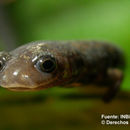Description
provided by AmphibiaWeb articles
Diagnosis:The species cannot be distinguished from O. gracilis and O. uniformis morphologically, but major differences are recognized genetically. Moderately sized grayish-black salamander (adults 108 to 175 mm TL) with a very long tail (64 to 72% of TL). The head is moderately broad and the snout is bluntly rounded. Maxillary teeth 32 to 43 in count. This species has short legs with tiny hands and feet. Costal grooves number 19 to 20 (Savage 2002).Description:Oedipina pacificensis is a worm salamander of the family Plethodontidae (the "lungless salamanders"). The body is extremely slender and elongate with short limbs and tiny hands and feet (Savage 2002). Hands and feet are syndactylous with four toes on forelimbs and five toes on hindlimbs. The tail is very long (64% to 72% of total length) (Savage 2002). The snout-vent length of an adult male is generally 26 to 48 mm and adult females are 39 to 51 mm in standard length (Savage 2002). Adults are 108 to 175 mm in total length (Savage 2002). Salamanders of this species have 19 to 20 costal grooves on the sides of its bodies (Savage 2002). This species has a moderately broad head with a bluntly rounded snout (Savage 2002). A sublingual fold is present (Savage 2002). There are 32 to 43 maxillary teeth present and 20 to 26 vomerine teeth (Savage 2002). Oedipina pacificensis is grayish-black in color, often with a whitish area near limb insertions or joints (Savage 2002). This species also has white post-ocular stripes (Taylor 1952). It cannot be distinguished morphologically from O. gracilis and O. uniformis, but there are major genetic differences for O. pacificensis (Good and Wake 1997).This species was first described by Taylor (1952), but was then subsumed by Brame (1968) into O. uniformis. Subsequently, Good and Wake (1997) described O. uniformis genetic differentiation and recognized O. pacificensis as a cryptic species. A Spanish-language species account can be found at the website of Instituto Nacional de Biodiversidad (INBio) (http://darnis.inbio.ac.cr/FMPro?-DB=UBIpub.fp3&-lay=WebAll&-Format=/ubi/detail.html&-Op=bw&id=4361&-Find).
- Bolaños, F., Chaves, G., Savage, J., Wake, D., and Ibáñez, R. (2008). Oedipina pacificensis. In: IUCN 2010. IUCN Red List of Threatened Species. Version 2010.1. www.iucnredlist.org. Downloaded on 07 April 2010.
- Laurencio, D., and Malone, J. H. (2009). ''The amphibians of Parque Nacional Carara, a transitional herpetofaunal assemblage in Costa Rica.'' Herpetological Conservation and Biology, 4(1), 120-131.
- Taylor, E.H. (1952). ''A review of the frogs and toads of Costa Rica.'' University of Kansas Scientific Bulletin, 35(5), 577-942.
- author
- Christine Isabel Javier
Distribution and Habitat
provided by AmphibiaWeb articles
Oedipina pacificensis is found in the humid lowlands on the Pacific slope of southern Costa Rica and in a small area of adjacent southwestern Panama at an altitudinal range of 5-1200 m asl (Bolaños et al. 2009). This species is primarily fossorial and is commonly found in leaf litter usually around tree buttresses and along road cuts between very wet moss or beneath rotting logs in forested areas (Brame 1968).
- author
- Christine Isabel Javier
Life History, Abundance, Activity, and Special Behaviors
provided by AmphibiaWeb articles
Oedipina pacificensis is a leaf-litter dweller and is found near tree buttresses. It breeds by direct development and does not require water for breeding. It tolerates disturbed habitats and is often found in old plantations (Bolaños et al. 2009).
- author
- Christine Isabel Javier
Life History, Abundance, Activity, and Special Behaviors
provided by AmphibiaWeb articles
This species is common with a stable population trend. There may be some evidence to suggest that Oedipina pacificensis is threatened by habitat destruction, but this species generally faces few threats. It occurs in several protected areas: Manuel Antonio, Carara, and Corcovado Golfito National Parks in Costa Rica. None of its habitat is protected in Panama (Bolaños et al. 2009).
- author
- Christine Isabel Javier
Oedipina pacificensis
provided by wikipedia EN
Oedipina pacificensis is a species of worm salamander in the family Plethodontidae. It is found on the Pacific slope of southwestern Costa Rica and adjacent Panama.[1][2][3] it is morphologically indistinguishable from O. gracilis and O. uniformis, but is genetically clearly distinct.[3]
Description
Adult males measure 26–48 mm (1.0–1.9 in) and adult females 39–51 mm (1.5–2.0 in) in snout–vent length. The tail is longer than the body, such that adults have a total length of 108–175 mm (4.3–6.9 in). The body is very slender and elongate, with short limbs and tiny hands and feet; the digits are syndactylous (fused together). The head is moderately broad with bluntly rounded snout. There are 19–20 costal grooves. Coloration is grayish-black, often with a whitish area near limb insertions or joints. There are also white post-ocular stripes.[3]
Habitat and conservation
Oedipina pacificensis is a leaf-litter inhabitant that is often found near tree buttresses. It occurs in lowland moist and wet forests and premontane rainforest at elevations of 5–1,200 m (16–3,937 ft) above sea level. Development is direct[1][3] (i.e., there is no free-living larval stage[4]). It is a common species that can adapt to disturbed habitats. It is facing no major threats. It occurs in a number of protected areas in Costa Rica.[1]
References

- license
- cc-by-sa-3.0
- copyright
- Wikipedia authors and editors
Oedipina pacificensis: Brief Summary
provided by wikipedia EN
Oedipina pacificensis is a species of worm salamander in the family Plethodontidae. It is found on the Pacific slope of southwestern Costa Rica and adjacent Panama. it is morphologically indistinguishable from O. gracilis and O. uniformis, but is genetically clearly distinct.
- license
- cc-by-sa-3.0
- copyright
- Wikipedia authors and editors

